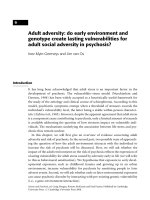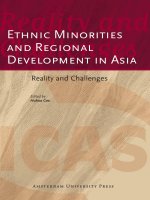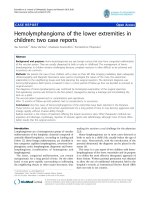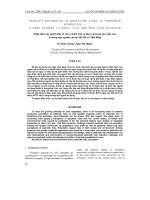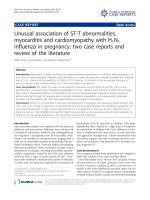ICT projects social development in asia two case studies exploring options, opportunities constraints
Bạn đang xem bản rút gọn của tài liệu. Xem và tải ngay bản đầy đủ của tài liệu tại đây (1.01 MB, 144 trang )
ICT PROJECTS AND SOCIAL DEVELOPMENT IN ASIA: TWO
CASE STUDIES EXPLORING OPTIONS, OPPORTUNITIES AND
CONSTRAINTS
MANJARI KISHORE
MASTER OF ARTS
COMMUNICATIONS AND NEW MEDIA PROGRAMME
NATIONAL UNIVERSITY OF SINGAPORE
SINGAPORE
2007
i
Acknowledgement
This thesis is the end product of efforts, encouragement and support from several
quarters. My dad is no more but I firmly believe whatever good happens in my life is
only due to his good deeds. “Thanks, papa!”
This CNM Master’s programme would never have happened in my life had it not
been for the strong encouragement from my mother who nurtures a unique belief of
earning more and more degrees.
This thesis could take its final shape due to constant support of my supervisor,
Dr.TT Sreekumar. I am greatly indebted to him for his continuous guidance and support.
Coming from science and journalism background, he must have come across tough
moments grooming me into a researcher and a thesis writer, but he advised and guided all
through with utmost calm, patience and sincerity. This task could really be accomplished
only due to his efforts and guidance.
Among other faculty members of CNM, I would like to extend my gratitude to
Dr.Milagros Rivera, Dr.Lim Sun Sun and Dr.Hichang Cho for all their advices,
suggestions and tips on doing good field work and a good thesis.
One person who finds special mention is Jayan Thomas for always being around
whenever there was a need. I really appreciate his help at almost every stage of my thesis.
Sudeep, my husband has been another pillar of support all through my second inning as a
student. I take this opportunity to thank him for all his support on the home front and in
IT related work during my research. Sameeksha, my daughter has been very kind in
leaving me with enough time and energy to complete my project and also giving me
ii
moments of playful relaxation during stressful episodes of my work. I am thankful to my
brother, Manish for all his words of encouragement and help in getting me some relevant
documents for my research.
Although, they might be aware but I formally like to thank all my friends in the
department whose constant support –emotional and otherwise – has made this journey of
Master’s programme not only easy but also memorable. I would especially like to thank
Minu, Pratichi, Shankar, Nandini, Shansi and of course, Raj for always being there for
me.
Last but not the least; I take this opportunity to thank Warren Wong and
Vasoontara for helping me with the leads for Thailand field study. Had it not been for
their support and co-operation, Thailand case study would not have been possible. I
sincerely appreciate your contributions.
iii
Table of Contents
Acknowledgement .......................................................................................................... ii
Table of Contents ...........................................................................................................iv
Summary ........................................................................................................................vi
List of Tables............................................................................................................... viii
List of Figures ................................................................................................................ix
1
Introduction: Issues and concepts.............................................................................1
1.1
ICT and Development ............................................................................................................. 1
1.2
Digital Divide......................................................................................................................... 2
1.3
ICTs, Women and Development: A Survey of Literature .......................................................... 7
1.3.1
Women and Development .................................................................................................. 9
1.3.1.1
1.3.2
1.3.3
1.4
1.4.1
1.4.2
1.5
1.6
1.7
1.8
1.9
2
Methodology..........................................................................................................29
2.1
2.2
2.3
2.4
2.5
2.6
2.7
2.8
2.8.1
2.8.2
2.9
3
Approaches to doing ‘gender’................................................................................................10
Women and Technology .................................................................................................. 12
Gender-ICT: A Recent Outlook........................................................................................ 13
Bringing ICTs to the ‘Un-connected’ .................................................................................... 16
Telecentres ...................................................................................................................... 16
Case studies focusing on Women’s Development ............................................................. 18
Concept of ‘Community’....................................................................................................... 21
Concept of ‘Social capital’.................................................................................................... 22
Issues and Concepts: Discussion........................................................................................... 24
Research Questions .............................................................................................................. 26
Thesis Structure.................................................................................................................... 27
Introduction.......................................................................................................................... 29
Social Sciences Research: Theoretical perspectives............................................................... 30
Feminist perspective ............................................................................................................. 32
Limitations of Qualitative Research ...................................................................................... 34
The Regional Focus: India and Thailand .............................................................................. 35
Field Work ........................................................................................................................... 37
Questionnaire Construction .................................................................................................. 40
Issues in the Field................................................................................................................. 41
India ................................................................................................................................ 41
Thailand .......................................................................................................................... 42
Limitations of the Study ........................................................................................................ 43
The two telecentres: Context and Background........................................................45
3.1
Introduction.......................................................................................................................... 45
3.2
Seelampur Telecentre Project in Context............................................................................... 45
3.2.1
Status of ICT in India: An overview ................................................................................. 45
3.2.2
Mission 2007 ................................................................................................................... 46
3.2.3
e-readiness of Indian states (New Delhi)........................................................................... 47
3.2.4
New Delhi: A glimpse of the demographics...................................................................... 48
3.2.5
Slums in India: An overview ............................................................................................ 49
3.2.5.1
3.2.5.2
Slums in New Delhi ..............................................................................................................50
Seelampur Context................................................................................................................51
3.2.6
The Seelampur ICT Centre Project ................................................................................... 51
3.3
Jakkarat Telecentre Project in Context.................................................................................. 53
3.3.1
Status of IT Industry: An Overview.................................................................................. 53
3.3.1.1
3.3.1.2
Hardware Industry ................................................................................................................54
Software Industry..................................................................................................................54
iv
3.3.2
ICT Policies of Thailand .................................................................................................. 55
3.3.2.1
3.3.2.2
3.3.2.3
3.3.3
IT 2000.................................................................................................................................55
IT 2010.................................................................................................................................55
ICT Master Plan for 2002-2006 .............................................................................................56
Telecentres in Thailand .................................................................................................... 57
3.3.3.1
PDA .....................................................................................................................................60
3.4
Jakkarat context ................................................................................................................... 61
3.4.1
Jakkarat T-Centre: A background ..................................................................................... 62
4
ICT: A Gateway to Employment? ..........................................................................64
4.1
Introduction.......................................................................................................................... 64
4.2
India .................................................................................................................................... 65
4.2.1
An overview of IT industry .............................................................................................. 65
4.2.2
Employment in IT industry............................................................................................... 65
4.2.2.1
4.2.2.2
4.2.2.3
4.2.2.4
4.2.2.5
4.2.2.6
4.2.2.7
Seelampur ICT Centre Project ...............................................................................................67
Age distribution across Telecentre Users................................................................................68
Distribution of Educational Qualifications .............................................................................70
Seelampur Women: Economic occupation remains elusive.....................................................71
Reasons for Adopting ICT training: An analysis ....................................................................73
Employment Status: A Reality Check ....................................................................................75
Hopes Vs. Reality .................................................................................................................76
4.3
Thailand............................................................................................................................... 77
4.3.1
IT in Thailand: An Overview............................................................................................ 77
4.3.2 Human Resource in IT ..................................................................................................... 79
4.3.3
Computer Usage Pattern in Establishments....................................................................... 80
4.3.4
The Jakkarat Telecentre under Thailand Canada Telecentre Project................................... 81
4.3.4.1
4.3.4.2
4.3.4.3
4.3.4.4
4.4
4.5
4.6
5
Distribution of telecentre users across age groups...................................................................82
Distribution of telecentre users across educational levels ........................................................83
ICT: Associated perceptions..................................................................................................84
ICT: Expectations Vs Reality ................................................................................................86
Perceptions and Actions at the two telecentre locations: A comparison.................................. 87
Employment prospects of the two telecentre users: A Comparison ......................................... 90
Conclusion ........................................................................................................................... 92
Telecentre: Potential Site for Community and Social Capital .................................95
5.1
Community Building: The influencing factors........................................................................ 95
5.1.1
Seelampur Telecentre: Birth of a community .................................................................... 96
5.1.1.1
5.1.1.2
5.1.1.3
5.1.1.4
5.1.2
The Physical infrastructure....................................................................................................97
Computer Activities ..............................................................................................................98
Location and Nature of the centre ........................................................................................100
Woman-Only telecentre ......................................................................................................101
Jakkarat T-Centre........................................................................................................... 103
5.1.2.1
5.1.2.2
5.1.2.3
5.1.2.4
5.1.2.5
User Profile and pre-telecentre association...........................................................................103
Socio-Cultural Historiography of Thai women .....................................................................104
Jakkarat T-Centre: The physical set-up ................................................................................105
Computer activities .............................................................................................................106
Location and nature of centre ..............................................................................................108
5.1.3
Role of Actors (In Seelampur and Jakkarat Telecentre Projects)...................................... 109
5.2
Conclusion and Recommendations for Social Capital Generation........................................ 112
5.2.1
Jakkarat Context, Thailand............................................................................................. 112
5.2.2
Seelampur Context, India ............................................................................................... 114
6
Conclusion...........................................................................................................117
6.1
6.2
6.3
Summary of Findings.......................................................................................................... 119
Recommendations............................................................................................................... 123
Suggestions for Future Research......................................................................................... 124
References...................................................................................................................125
Appendix A .................................................................................................................135
v
Summary
Telecentres, as a hub of Information and Communication Technology (ICT)
services have widely proliferated, especially in the developing countries as a measure to
bridge the digital divide and connect the remote and marginalized populations, ultimately
realizing the goals of social, political and economic empowerment.
Feminist literature on women’s development in the trajectory of technological
growth argues that historically the relationship between women and new technologies has
been mediated by problematic assumptions deriving from the crucible of patriarchy. But
recent literature shows that ICTs have enabled social and economic empowerment of
women by providing greater employment opportunities and redefining gender relations at
the family and community level.
This thesis aims to critically examine the extent of empowerment of marginalized
women through employment generation and community formation brought about by
ICTs. For the purpose of this study, we narrow the broad area of ICTs to the sphere of
telecentres, particularly in the developing countries.
The study takes a cross-country perspective by selecting two telecentre sites –one,
Seelampur ICT Centre located in a slum area in New Delhi in India and second, Jakkarat
T-Centre at the Jakkarat village in Korat province of Thailand. In-depth interviews were
carried out with the aid of semi-structured questionnaire. The sample size was 41 in India
and 28 in Thailand case study; sampling frame constituted mostly of women.
Based on the findings of the field study, this paper specifically answers the
question whether ICTs through the medium of telecentres, provide employment or
vi
income-generating activities, and scope for community formation for enabling economic
and social empowerment of women from the disadvantaged communities. This research
is significant in that it is based on empirical research from a user-centered perspective.
Findings show that the telecentres are being visited by the younger and the
relatively better educated among the local communities primarily with the hope of
securing employment. The study finds that getting IT-based employment is contingent on
the over-all social, educational and cultural context in which the telecentre users are
embedded. The study also highlights that though ICTs are enablers of offline community
building, it is the social context of women in the respective communities that influence
formation of a community.
vii
List of Tables
Table 1.1: Population, Internet users and Internet penetration of selected Asian countries4
Table 3.1: An outline of telecentre initiatives undertaken by various organizations in
Thailand.................................................................................................................58
Table 4.1: Qualification Level of Professionals in the IT Industry (India) ......................67
Table 4.2 : Age Distribution across telecentre users. ......................................................68
Table 4.3 : Distribution of telecentre users and non-users by their level of education,
(Seelampur ICT Centre Project, India, as % of total) ..............................................71
Table 4.4 : Distribution of telecentre users and non-users by their level of education,
(Jakkarat Telecntre Project, Thailand, % of Total)..................................................83
Table 5.1: The physical infrastructure at Seelampur ICT Centre and Jakkarat T-Centre .97
Table 5.2 : Rank Order of Computer Activities undertaken by telecentre users at
Seelampur ICT Centre, India..................................................................................99
Table 5.3: Profile of the telecentre users interviewed at Seelampur ICT Centre, India..102
Table 5.4: Profile of the Telecentre users interviewed at Jakkarat T-Centre..................104
Table 5.5: Rank order of Computer Activities undertaken by Telecentre visitors at
Jakkarat T-Centre, Thailand .................................................................................107
viii
List of Figures
Figure 1.1: Internet penetration by World Region ............................................................3
Figure 1.2: Unequal legal, social and economic rights between men and women in
regions of the world ...............................................................................................11
Figure 1.3: Gender disparities tend to be greater among the poor than the rich...............12
Figure 3.1: e-readiness index of Indian states................................................................48
Figure 3.2: ICT Development Programme under IT 2010 ..............................................56
Figure 4.1: Distribution of Thai Internet Users by Location (in 2000) ............................78
Figure 4.2: Thai Internet market ....................................................................................78
Figure 4.3: Percentage of establishments against computer by reason and planning in year
2006.......................................................................................................................81
Figure 4.4: Computer Penetration in Thai Schools .........................................................90
ix
1 Introduction: Issues and concepts
1.1 ICT and Development
Ever since the advent of the Internet and computer technology there has been
great optimism about the development promises it holds out and the revolution that it
could set off. At the same time, a growing realization of the ‘inequities’ in the availability
of the digital opportunities across different sections of the world’s population has also
prevailed. Such inequities that have become an issue of great concern in the Information
Age are to some extent a continuation of social, economic and gender-based inequalities.
This gap between those with access to Information and Communication Technologies
(ICTs) and those without is called the ‘digital divide’. Around 85% of the world’s
population lack Internet experience (InternetWorldStatistics, 2007), indicating the
severity of the digital divide within and between nations. The digital divide overshadows
the ICT-related optimism, and portends real dangers that ICTs might exacerbate the
existing social asymmetries.
The severity of the issue and the dangers it entails is echoed in Kofi Annan’s (2002)
statement,
“The new information and communication technologies are among the driving
forces of globalization. They are………… bringing decision makers
unprecedented new tools for development. At the same time, however, the gap
between the ‘haves’ and ‘have-nots’ is widening, and there is a real danger that
the world’s poor will be excluded from the emerging knowledge-based global
economy.”
ICTs, by themselves do not discriminate between individuals-- men or women.
However, in conjunction with other social and cultural dynamics, ICTs put women who
1
have been embedded within patriarchal contexts, in a severely disadvantaged position
compared to men, leading to gender gap within the digital divide.
Realizing the threats of the gender digital divide, the state, civil society and the
market have come together to bridge the gap with strategic deployment of ICTs among
the marginalized communities. Some ICT initiatives are exclusively for women. There is
a view that attention to ICTs means diversion of attention from basic necessities like
food, shelter, health and education. But technological optimists argue that addressing the
problem of digital divide in the initial phase of the Information Age is urgent as
developing countries could derive huge benefits by leapfrogging into the new
technologies. Another factor for urgency is the sheer ‘number’ of people affected by the
digital divide.
1.2 Digital Divide
The growth of the Knowledge Society and the growing divide between the
Information haves and have-nots has evolved almost in tandem. Although it is argued that
this Information Age is only the second phase of the already existent Industrial
Revolution, the significance of ICTs is reflected in the fact that the present era has come
to be known as either Information Age or Digital Age. What distinguishes the present era
of Information Age from the Industrial Age is the rapidity with which it is revolutionizing
almost every aspect of our everyday living. The rapidity in change has been such that
globalization has become a much talked about ‘concept’ in the last two decades. Nasir
(2001) states that new technologies like wireless communications and the Internet are
combining with the process of globalization to change the environment for development,
leading to the creation of ‘Network Age’.
2
Though the speed of communication has become phenomenal with the World
Wide Web, what is crucial for our understanding is the nature of this ‘growth’. Even in
this phase of intensive-globalization -- owed to ICTs, there is only a meager 16.6% of the
world population that have experienced Internet (Internet World Statistics, 2007).
According to Internet World Stats (2007), Internet penetration in North America
is 69.4% while in Asia it is 10.5% and Africa 3.5% (See Figure 1.1).
Figure 1.1: Internet penetration by World Region
(Source: Internet World Stats, 2007)
The countries of Asia present diverging Internet usage statistics, with Hong Kong
showing highest Internet Penetration at 69.2% and Japan, Singapore and South Korea
showing 67.2%, 67.2% and 67% respectively, whereas poorer countries like Afghanistan,
Bangladesh and Myanmar have Internet penetration at 0.1%, 0.2% and 0.1%, respectively
(See Table 1.1).
3
Table 1.1: Population, Internet users and Internet penetration of selected Asian countries
Asian Countries Population
(2006 Est.)
Hong Kong
Internet Users
(Latest Data)
Penetration
(Percentage
Population)
69.2 %
7,054,867
4,878,713
128,389,000
86,300,000
67.2 %
3,601,745
2,421,000
67.2 %
South Korea
50,633,265
33,900,000
67.0 %
Taiwan
22,896,488
13,800,000
60.3 %
1,129,667,528
60,000,000
5.3%
Thailand*
67,249,456
8,465,800
12.6%
Afghanistan
26,508,694
30,000
0.1 %
Bangladesh
136,138,461
300,000
0.2 %
15,017,110
41,000
0.3 %
5,719,497
25,000
0.4 %
54,021,571
78,000
0.1 %
Japan
Singapore
India*
Cambodia
Laos
Myanmar
(Source: Adapted from Internet World Stats Report, 2006; *Data for India and Thailand are taken from
Internet World Stats, 2007) i
These figures reflect that while some countries have achieved relatively higher
Internet penetration, there are others like Afghanistan and Myanmar that are at the other
end of the spectrum. India and Thailand are in between showing rising Internet Usage
growth, which became one of the reasons for selecting these two countries in the region
for case studies. As seen in Table 1.1, the divide between nations (and even within them)
has become the focal point of concern for policy makers and practitioners of ICT for
development. These concerns have given birth to a large body of literature on analytical
issues related to digital divide.
4
Llyod Morrisett, former President of Markle Foundation was the first to use the
term Digital divide to mean the divide between the information ‘haves” and the
information “have-nots”. Many of the researchers have tried to define ‘digital divide’
based on different factors like “access to the Internet, extent of use, knowledge of search
strategies, quality of technical connections and social support, ability to evaluate the
quality of information and diversity of uses” (Dimaggio, Haggittai, Neuman & Robinson,
2001). Nevertheless, Bucy (2000) and Van Dijk and Hacker (2003) argue that most of the
digital divide work refer to such a divide in relation to Internet ‘access’ and not as much
on the differences in Internet usage. Grabill (2003) also maintains that access to
information isn’t particularly useful; “people need to be taught how to use information…
(and) produce content for computer networks to be meaningful spaces.”
Pippa Norris (2001) in explaining the multidimensional nature of digital divide
gives a three-tier understanding of the concept based on three different aspects. First is
the ‘global divide’ which looks at the discrepancies in the Internet access between the
developed and the developing nations, second is ‘social divide’ which exists between
information haves and have-nots within each country and third, ‘democratic divide’
which exists among the users of Internet between those who do and do not actively
engage in using these resources to participate in public life.
Keniston (2004) argues that there are four types of digital divide that separates
those included in and excluded from the Information Age. The first type exists within
every nation whether developed or developing, between the rich, educated and powerful
and those who are poor, uneducated and not powerful. The second digital divide is
attributed to the linguistic and cultural factors; the third type follows from the first two by
5
furthering a divide between the rich and the poor nations and the fourth has emerged
from the emergence of a new class ‘digerati’ii who with their education, brainpower and
ability to live on the cutting edge of knowledge have become the true beneficiaries of IT
evolution.
These definitions and classifications reflect on the patterns of the digital divide,
an understanding of which is crucial as the need to bridge the digital divide is paramount
at a time when ICTs are increasingly being recognized as development enablers.
One solution for bridging the digital divide has been telecentres. Earlier research
had put a lot of thrust on economic issues as factors responsible for digital divide. But
more recently, studies have focused on non-economic factors like social and cultural to
be equally critical for access, adoption and usage of ICTs. And with extensive growth of
cybercafés and Information kiosks the thrust on social and cultural dimensions is
increasingly escalating. Keeble and Loader (2001) state , “…….To be without access to
the Web in the Information Age , it seems, is to run the risk of losing competitive
advantage in the race for economic prosperity. Yet information, knowledge and its
communication are not simply economic variables, they are also cultural assets.”
With the concept of community shared resources like that of telecentres that have
emerged as an ‘effective’ way to reach the masses , particularly the disadvantaged in
terms of lack of resources, ‘access’ to technology is no more the prime deterrent in
technology adoption. Yet digital divide persists. Women face even more complex issues
due to their positioning in the patriarchal context.
As telecentres are based on the concept of shared resources of a community, the
concepts of community and social capital, which is fundamentally a feature of a
6
community is of great relevance. Hence, this study pursues a review of these two
theoretical concepts ultimately aiming to examine ICT’s influence on formation of
community and social capital.
1.3 ICTs, Women and Development: A Survey of Literature
Studies show that gender equality improves the development of society. Hence,
‘women empowerment and promotion of gender equality’ received a separate mention as
one of the eight Millennium Development Goals (MDGs). As is the case with other kinds
of gender inequities, gender digital divide too forms an area of urgent action because if
women are not included in the formative years of Information Age, their voices would
remain unheard even in the future, further exacerbating the gender divide in digital
domain (Mitter & Ng, 2005).
Green (1993) argues that women’s use of new ICTs can provide opportunities for
achieving unfulfilled gender needs or they can remove socio-economic barriers
threatening opportunities for women’s employment, their health, safety and
independence.
Recent studies have shown that ICTs are having positive impacts on women’s
development subsequently furthering gender equality. However, evidences show that the
expansion of ICTs is somehow reinforcing rather than eliminating such deeply embedded
gender-based social divisions. "Few countries collect gender ICT statistics and those that
do so are typically the countries where the gender digital divide is least marked..... Those
countries where the gender digital divide is most marked are also those where the digital
divide in general is hardest to document……Again, the available data reflects the fact
that the gender data divide mirrors the global digital divide" (Hafkin, 2003).
7
Hence, the contested view that women are increasingly taking advantage of ICT
in all spheres of life, thus projecting ICT as a tool to promote gender equality and
enhance the economic, political and social empowerment of women, needs to be
reassessed.
In this thesis, we draw attention to the fact that with the advent of telecentres, the
issue of access to computer technology has been addressed to a great extent in the remote
areas. But still diffusion/adoption of technology remains a challenge. Gender digital
divide continues to remain an issue of concern for development practitioners.
As we proceed, we will first look at the ‘women and development’ agenda and its
importance in the discourse of development. Next, we trace the various stages in which
women and development issue evolved in respect of ‘doing gender’ with the ultimate aim
of empowering women. The next section looks specifically at the feminist perspectives
on ‘gender and technology’ providing a backdrop for an understanding of more recent
studies on women’s social and economic development through ICTs, including
employment generation. This structure of literature review starting with the issue of
development in respect of women and some feminist perspectives on ‘women and
technology’ provides a broad framework for the understanding of the following section
on the myriad ways in which ICTs are impacting women and their development.
The latter section reviews the telecentre movements, its goals and impacts, and a
few telecentre projects in developing countries. Telecentre literature review has been
separately incorporated as this study looks at ICTs and its impact on women through the
telecentre lens. The last two sections are a review of the concepts of ‘community’ and
8
‘social capital’ to understand their dynamics in relation to women’s development through
ICTs.
1.3.1 Women and Development
Information and Communication technologies in the last two decades have evolved as
a potent tool in transforming social, economic and political dimensions of everyday lives
across the globe. All the countries and societies of the world have to be a part of this fastpaced IT revolution to avoid any marginalization in this Information Age. Speaking of
marginalization, one section which draws utmost concern is women, as they are poor and
they are ‘women’. Being ‘women’ assumes a peculiarly special meaning in the context of
technological development as ‘women’s relationship with new technologies have
historically been mediated by problematic assumptions relating to the gender of
‘expertise’’ (Cockburn, 1981).
Studies show evidences drawn from comparisons at the national and sub-national
scale that societies which discriminate on the basis of gender pay a price in more poverty,
slower growth and a lower quality of life, while gender equality enhances development
(Momsen, 2006). Hence, the internationally agreed eight MDGs mention separately of
empowerment of women and promotion of gender equality (United Nations, 2005).
Today gender equality makes one of the major concerns in the development arena
as studies indicate that historically –until the early 1970s--development policies were
directed at women in the context of wives and mothers (Momsen, 2006). Boserup (1970)
challenged the then conventional wisdom that the benefits of macroeconomic policies
would benefit all including the poor, and the poor women would also benefit as the
9
economic conditions of their husbands would improve. Boserup (1970) argues that
women were being associated with the backward and traditional and were losing status.
1.3.1.1 Approaches to doing ‘gender’
A new thrust on women’s development was perceptible with institutionalization of
Women in Development (WID) policies. By the 1980s, the advocates of WID started to
focus on how the development efforts are losing out by ignoring women’s actual or
potential contribution. The WID approach was criticized for considering women as a
homogenous category which led to a distinction between ‘practical’ gender needs which
improves women’s lives within their existing roles and ‘strategic’ gender needs which
attempts to enable women to take on new roles and empower them (Moser, 1993). But
many women activists and development practitioners, especially from the South,
continued to see the ‘women and development’ strategies as lacking the perspective of
developing countries.
In the 1980s, aiming to bring gender in the mainstream development strategies,
the approach of empowerment through grassroots and participatory activities evolved as a
weapon for the weak (Parpart, 2002, quoted in Momsen, 2006). Empowerment in this
context meant enabling people to gain self-confidence and self-esteem by way of
allowing both men and women to actively participate in development decision-making
(Rowlands, 1997). Another approach in the evolution of ‘gender and development’
discourse was ‘ecofeminism’ primarily advocated by Vandana Shiva (1988) who makes a
case for environmental programmes to focus on women’s roles.
Such approaches were also seen as not adequate in addressing the issue of gender and
gender relations in a way which could ensure development for women which led to the
10
concept of ‘gender mainstreaming’ which would also overcome the problems of male
backlash against women when women-only projects are successful (Momsen 2001,
2006).
Even though there has been progress in the agenda of incorporating gender in the
development discourse, with special emphasis on mainstreaming gender in development,
since the Beijing Conference in 1995, figures show there is yet a significant gender gap
on various development parameters. In no region of the world do men and women fare
equally in legal, social and economic rights (See Figure 1.2).
The World Bank report (2005) indicates that violence against women persists and
huge gaps in earnings continue in most countries. It states that gender differences in work
experience, employment characteristics and education explain only a fraction of this gap.
Women make 57% of the total 104 million children aged 6 -11 years not enrolled in
schools, and they make two-thirds of the 860 million non-literates worldwide (UNESCO,
2003).
Figure 1.2: Unequal legal, social and economic rights between men and women in regions of the
world
Note: the value of 1 indicates low gender equality in rights, and value of 4 indicates high equality
(Source: World Bank, 2001a, quoted in World Bank, 2005).
11
Studies also show that gender disparities are greater among the poor than the rich
(See Figure 1.3). Women continue to be greatly underrepresented in positions from where
they could influence decision –making. Women make only 16.9% of the total of both the
Parliament houses combined worldwide (Inter-Parliamentary Union (IPU), 2007).
Figure 1.3: Gender disparities tend to be greater among the poor than the rich
(Source: World Bank, 2001)
In the last three decades, strides have been made in improving the status of women
and establishing gender equality in terms of education, labour force participation, health
and other areas. However, gender inequalities persist in matters of exercising rights,
decision-making, access to opportunities and making voices heard (World Bank, 2001).
1.3.2 Women and Technology
Modernization--of which technological evolution makes a part-- and restructuring
of traditional economies, “often increases the disadvantages suffered by women as the
modern sector takes over many of the economic activities… A majority of the new and
12
better-paid jobs go to men and male income is less likely to be spent on the family”
(Momsen, 1991). With regard to technology, the feminist perspective argues that
technology has often been constructed as masculine and non-social, amid beliefs that the
practices of women are almost always non-technological (Wajcman, 1991). Cockburn
(1985) also argues that technology is “…both the social property and one of the formative
processes of men. …The appropriation of muscle, capability, tools and machinery by
men is an important source of women’s subordination; indeed it is part of the process by
which females are constituted as women”.
In the context of the Information Age, Wajcman (1991) argues, “computer has
become socially constructed as a male domain”. Admitting the potential of
computing/computers “as a completely new type of technology to break the mould”,
Wajcman (1991) further states, the fact that boys outnumber girls in the usage of
computer technology, “our culture has already defined computers as pre-eminently male
–machines”.
In the backdrop of such a constructed meaning of technology through feminist
perspective and historiography of women’s progress amid technological development
delineated by feminist observers, it emerges that women remain in the deepest troughs of
the divide between the beneficiaries of technological revolution and non-beneficiaries,
worse off than men whose hardships they anyway share.
1.3.3 Gender-ICT: A Recent Outlook
Information and Communication Technology already considered a force in
transforming the economic, social and political life is already being seen in some ways as
gender equalizer within the ICT domain even in the developing countries. The shift
13
towards ICT-based services in the Information Age has led to a rapid growth of call
centres, Business Process Outsourcing and IT Enabled Services (ITES) that provide a
wide-range of off-site services to corporate clients within and without nations. The last
few years have seen a phenomenal growth of such centres in developing countries where
ITES are increasingly outsourced to low-waged, multi-lingual countries with relatively
low overhead costs (Ng & Mitter, 2005).
Studies have shown that a growing number of workers in these ITES are women.
Though many research emphasize on the negative impacts of such feminisation of labour
in IT sector leading to exploitation of women in the workplace (Gurumurthy, 2004) and
on its negative impacts on women’s working conditions like erosion of “even the basic
rights at work” (Remesh, 2004), there is a growing body of research that acknowledges
ICTs’ positive impacts.
Pearson (2000) argues that affordances made possible due to globalization and IT
enabled work has resulted in increased involvement of women in production and paid
employment. Other studies too acknowledge ICT’s benefits in developing countries in
terms of creating opportunities for employment (Mitter & Ng, 2005) and the ways in
which women have negotiated gender relations at the family and community level
(Kelkar & Nathan, 2002). Castells (2000) also argues that network technologies have
made patriarchy a ‘contested domain rather than a sphere of cultural reproduction,
leading to fundamental redefinitions of gender relations, family and sexuality’.
Highlighting women’s employment opportunities in the ICT sector, some studies
argue that in Malaysia, women’s presence in ICT sector is almost as perceptible as men’s
(Ng, 2005) and in India, almost 45% of 160,000 employees in the call centres are women
14
(Mitter, 2005). There are arguments that ITES like call centres, back office work
processing, medical transcription, etc. are going to significantly increase employment
opportunities for women unlike traditional manufacturing sector (Mitter, 2000).
Kelkar, Shrestha and Veena (2005) in their work on IT industry in India also
point out that the nature of IT work characterized by networking capacities and tools and
the individualization of these capacities have increased women’s decision-taking
capacities thereby enhancing their agency.
Research on ICT and women in Asia points out that the outsourcing phenomenon
would provide major opportunities for the economic empowerment of women. An
expected 500% increase in India’s ICT services and back office operations involving jobs
of some four million IT workers by 2008, is expected to provide an immense
employment opportunity for women in this sector (Kripalani & Engardio, 2003).
In the Indian context, NASSCOM-McKinsey Report (1999) predicts the
employment in the ITES sector would exceed that generated by software development by
2008. But one common denominator emerging from the studies on the impacts of ICT in
the recent years is that it is mostly the better-educated, urban elite among the women with
better articulation and cognitive skills who get into the ITES sector. There are studies
which report that women from convents or English medium schools are preferred (Kelkar
et.al, 2005), employment opportunities would be open for urban elite who have the
advantage of knowledge of spoken and written English, thus not making any
transformation in the aggregate employment patterns in the near future (Vijayabaskar,
Rothboeck & Gayathri, 2001).
15
Hafkin and Taggart (2001) in their work on IT and gender in Developing
Countries argue that the jobs gained by women in the IT sector are largely associated
with areas with high rates of female literacy in Latin America and Asia, notably in
Philippines, Thailand and Vietnam.
1.4 Bringing ICTs to the ‘Un-connected’
The role of ICTs in sustained development has been clearly acknowledged by policy
makers and development practitioners leading to an array of ICT-based initiatives at
various levels with the similar goal of ‘development’ for all the world’s population. Some
concrete steps taken in the direction by the United Nations alone include formation of
UNICT (United Nations Information and Communication Technology) Taskforce in
2001 for formulating strategies on how to deploy ICT for development. Also, the World
Summit on Information Society was planned in two phases in 2003 and 2005,
underscoring the urgent need for ensuring benefits of ICTs for all.
The enthusiasm about ICT and its potential to transform the social, economic and
political dimensions of life has fostered further growth in the form of research,
workshops, telecentres and other activities, all targeted at IT-based development which
ultimately targets to bridge the growing digital divide between the Information ‘haves’
and ‘have-nots’.
1.4.1 Telecentres
In the last decade, telecentres have been one of the major forerunners in ICT for
development programmes by trying to connect the marginalized populations to the
Internet, computers and other related services. Based on the concept of shared resources,
telecentres, variously known as Information kiosks, Village Knowledge Centres, ICT
16
